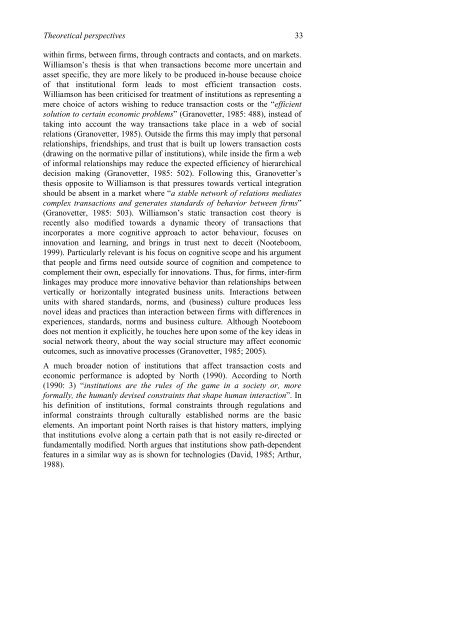Innovation and institutional change: the transition to a sustainable ...
Innovation and institutional change: the transition to a sustainable ...
Innovation and institutional change: the transition to a sustainable ...
You also want an ePaper? Increase the reach of your titles
YUMPU automatically turns print PDFs into web optimized ePapers that Google loves.
Theoretical perspectives 33<br />
within firms, between firms, through contracts <strong>and</strong> contacts, <strong>and</strong> on markets.<br />
Williamson’s <strong>the</strong>sis is that when transactions become more uncertain <strong>and</strong><br />
asset specific, <strong>the</strong>y are more likely <strong>to</strong> be produced in-house because choice<br />
of that <strong>institutional</strong> form leads <strong>to</strong> most efficient transaction costs.<br />
Williamson has been criticised for treatment of institutions as representing a<br />
mere choice of ac<strong>to</strong>rs wishing <strong>to</strong> reduce transaction costs or <strong>the</strong> “efficient<br />
solution <strong>to</strong> certain economic problems” (Granovetter, 1985: 488), instead of<br />
taking in<strong>to</strong> account <strong>the</strong> way transactions take place in a web of social<br />
relations (Granovetter, 1985). Outside <strong>the</strong> firms this may imply that personal<br />
relationships, friendships, <strong>and</strong> trust that is built up lowers transaction costs<br />
(drawing on <strong>the</strong> normative pillar of institutions), while inside <strong>the</strong> firm a web<br />
of informal relationships may reduce <strong>the</strong> expected efficiency of hierarchical<br />
decision making (Granovetter, 1985: 502). Following this, Granovetter’s<br />
<strong>the</strong>sis opposite <strong>to</strong> Williamson is that pressures <strong>to</strong>wards vertical integration<br />
should be absent in a market where “a stable network of relations mediates<br />
complex transactions <strong>and</strong> generates st<strong>and</strong>ards of behavior between firms”<br />
(Granovetter, 1985: 503). Williamson’s static transaction cost <strong>the</strong>ory is<br />
recently also modified <strong>to</strong>wards a dynamic <strong>the</strong>ory of transactions that<br />
incorporates a more cognitive approach <strong>to</strong> ac<strong>to</strong>r behaviour, focuses on<br />
innovation <strong>and</strong> learning, <strong>and</strong> brings in trust next <strong>to</strong> deceit (Nooteboom,<br />
1999). Particularly relevant is his focus on cognitive scope <strong>and</strong> his argument<br />
that people <strong>and</strong> firms need outside source of cognition <strong>and</strong> competence <strong>to</strong><br />
complement <strong>the</strong>ir own, especially for innovations. Thus, for firms, inter-firm<br />
linkages may produce more innovative behavior than relationships between<br />
vertically or horizontally integrated business units. Interactions between<br />
units with shared st<strong>and</strong>ards, norms, <strong>and</strong> (business) culture produces less<br />
novel ideas <strong>and</strong> practices than interaction between firms with differences in<br />
experiences, st<strong>and</strong>ards, norms <strong>and</strong> business culture. Although Nooteboom<br />
does not mention it explicitly, he <strong>to</strong>uches here upon some of <strong>the</strong> key ideas in<br />
social network <strong>the</strong>ory, about <strong>the</strong> way social structure may affect economic<br />
outcomes, such as innovative processes (Granovetter, 1985; 2005).<br />
A much broader notion of institutions that affect transaction costs <strong>and</strong><br />
economic performance is adopted by North (1990). According <strong>to</strong> North<br />
(1990: 3) “institutions are <strong>the</strong> rules of <strong>the</strong> game in a society or, more<br />
formally, <strong>the</strong> humanly devised constraints that shape human interaction”. In<br />
his definition of institutions, formal constraints through regulations <strong>and</strong><br />
informal constraints through culturally established norms are <strong>the</strong> basic<br />
elements. An important point North raises is that his<strong>to</strong>ry matters, implying<br />
that institutions evolve along a certain path that is not easily re-directed or<br />
fundamentally modified. North argues that institutions show path-dependent<br />
features in a similar way as is shown for technologies (David, 1985; Arthur,<br />
1988).
















